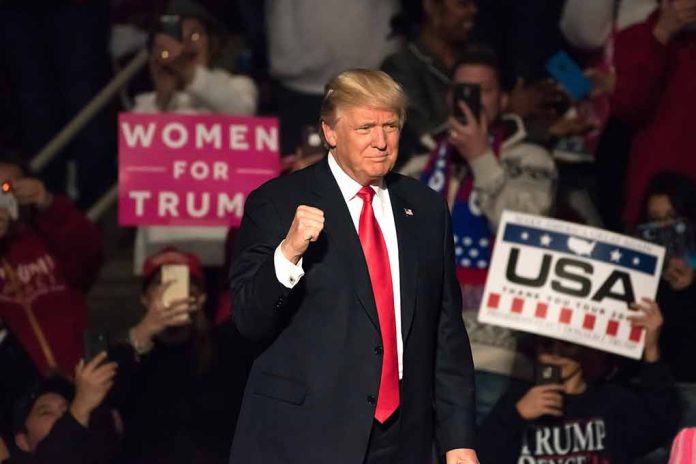
The economic boxing match between the US and China has intensified to unprecedented levels, with President Trump raising tariffs on Chinese products to a staggering 125% after China struck with an 84% hike on American goods, leaving global markets bracing for widespread disruption.
Top Takeaways
- President Trump announced a 90-day pause on tariffs for over 75 countries that didn’t retaliate against US duties, but significantly increased tariffs on China to 125%.
- China responded to the initial tariff rise by raising its own tariffs on US goods to 84% and declaring it would “fight to the end” against American economic pressure.
- The trade war is disrupting global supply chains, causing market volatility, and may lead to higher consumer prices in both countries.
- The dispute has expanded beyond tariffs, with China adding 11 American companies to an “unreliable entities” list and challenging US actions at the World Trade Organization.
Trump Takes Aggressive Stance Against China While Offering Olive Branch to Others
President Trump has implemented a strategic approach to global trade tensions by announcing a 90-day pause on tariffs for over 75 countries that refrained from retaliating against US duties. This pause offers breathing room to nations willing to negotiate, while pointedly excluding China, which now faces increased tariffs totaling 125%. The decision comes as part of Trump’s “America First” trade policy that aims to address what his administration views as unfair global trade practices.
Treasury Secretary Scott Bessent clarified that these tariff actions were designed to bring countries to the negotiating table rather than serving as permanent economic measures. The pause applies specifically to nations that chose not to retaliate against previous US tariff impositions, with Trump explaining the decision as a response to overreactions in the marketplace and general apprehension about potential economic consequences.
China’s Forceful Response Signals Prolonged Economic Conflict
China’s response to the US tariff increases has been swift and resolute. The Chinese Ministry of Commerce raised its own tariffs on American goods to 84% and issued a stark warning about its determination to withstand economic pressure. This escalation marks a significant intensification of the trade war between the world’s two largest economies, with potential ramifications extending far beyond their borders.
China has taken additional measures beyond tariffs, challenging US actions at the World Trade Organization and adding 11 American companies to an “unreliable entities” list. The Chinese government has also issued warnings to its citizens about traveling to the United States amid the rising tensions. These moves demonstrate China’s multifaceted approach to countering US pressure while protecting its economic interests.
Economic Impact Ripples Through Global Markets
The escalating trade war has already triggered significant market disruptions both in the US and internationally. Major US drugmakers have experienced a decline in shares, while retail giant Walmart withdrew its first-quarter operating income outlook due to uncertainties surrounding the tariff situation. These reactions highlight the immediate financial consequences of the trade dispute, with consumers and businesses bracing for potential price increases.
The trade relationship between the two nations is substantial, with the US exporting $199 billion to China last year, while China exported $463 billion to the United States. Key American exports to China include soybeans, aircraft, pharmaceuticals, and semiconductors, while major imports from China encompass mobile phones, computers, toys, and clothing. Disruptions to this trade flow could significantly impact supply chains and consumer prices in both countries.
Broader International Implications
The trade war between the US and China has created ripple effects throughout the global economy. The European Union has imposed its own retaliatory tariffs on US imports, ranging from 10% to 25%, further complicating the international trade landscape. The European Chamber of Commerce in China has criticized US tariffs for negatively impacting European companies and increasing operational costs, illustrating how the bilateral dispute has multilateral consequences.
China’s Commerce Ministry has warned that continued US tariffs could lead to financial market fluctuations, increased inflation, and potentially trigger an American economic recession. The dispute has even affected negotiations over TikTok, with a potential sale to American owners now delayed. As both economic powers dig in for what appears to be a prolonged conflict, businesses and consumers worldwide are caught in the crossfire of these escalating trade tensions.
Sources:
- Stocks surge after 90-day pause announced for most countries
- Trump hits back with a 125% tariff in escalating trade war with China
- Trump Pauses Tariffs on Nations That Did Not Retaliate, Ups Chinese Tariffs to 125 Percent







